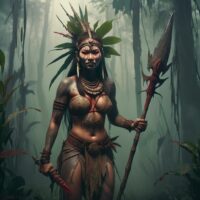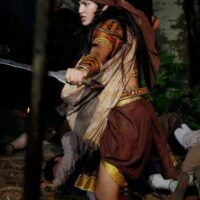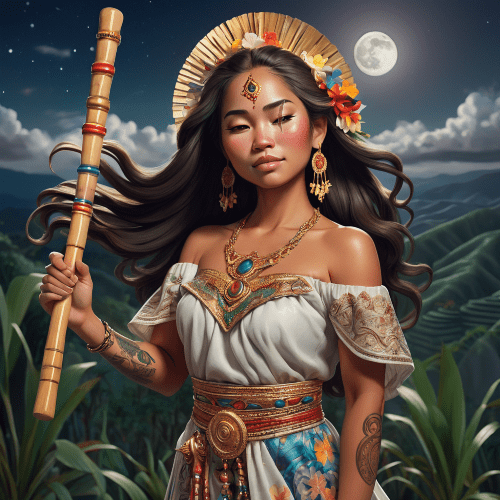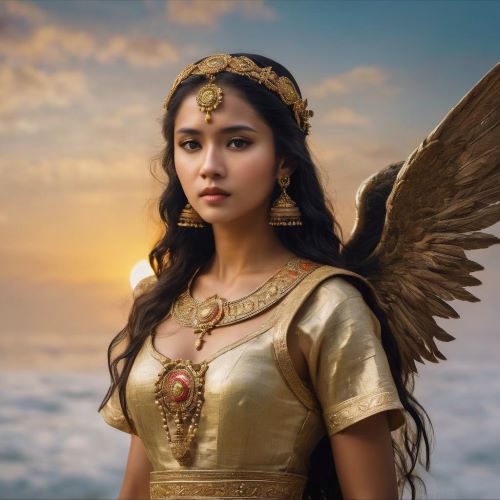Ynaguinid : Goddess of Poison
Listen
At a glance
| Description | |
|---|---|
| Origin | Philippine Mythology |
| Classification | Gods |
| Family Members | N/A |
| Region | Philippines |
| Associated With | War, Poison |
Ynaguinid
Introduction
Ynaguinid, sometimes spelled Inaginid, Ina Gunid, or Naguinid, is one of the most powerful and enigmatic deities in Visayan mythology. Revered primarily as a goddess of war and poisons, she was invoked by ancient warriors and tribal leaders before heading into battle. Her name first appeared in historical records such as Miguel de Loarca’s Relacion de las Yslas Filipinas (1582), where she was described as a divine patron of conquest, raiding, and conflict. Warriors, especially those from the Timawa class, believed that calling upon Ynaguinid, along with Makanduk and other divine figures, would bring them courage, skill, and success in their martial endeavors. Her presence in the mythological pantheon reflects the pre-colonial Visayan culture’s intimate relationship with war, valor, and the supernatural.
Physical Traits
The visual representation of Ynaguinid reveals her as a fearsome figure of divine might. Her form, often described through symbolic elements rather than rigid depictions, evokes awe and intimidation. Her entire body is said to be etched with intricate tattoos, each marking a victory or a life taken in battle—symbols of dominance and divine approval. She is frequently imagined with her face streaked with blood, not just from others, but sometimes her own, indicating ritualistic fervor and an intense connection to the violent ecstasies of war. Her sharpened, blackened teeth—colored using coal and local herbs—further emphasize her fearsome nature, blending beauty with menace. Ancient warriors mimicked this look to display their loyalty and channel her power. In some tales, she appears as a masculine figure clad in war attire, while in others she takes the form of a seductive yet deadly woman of the forest, signifying her transcendence beyond gender and her role as a shapeshifting force of nature.
Family
While Ynaguinid’s direct familial lineage isn’t explicitly detailed in most historical accounts, her mythological significance is tied closely with other prominent deities. She forms a notable divine alliance with Makanduk, a god associated with war and raiding. This duo was frequently invoked before sea-bound mangayaw raids or land-based warfare, serving as spiritual generals for the warriors. Additionally, she is occasionally mentioned alongside other deities like Balangaw, the god of rainbows and transitions, and Makbarubak and Arapayan, who are known for their association with charms and enchanted oils. These pairings suggest that her power was often part of a broader constellation of gods dealing with battle preparation, magical defense, and spiritual protection.
Other Names
Ynaguinid is known by various names depending on regional dialects and oral traditions. Among the Tagalog and northern Philippine tribes, she is often referred to as Naguinid or Nagined, a variation that emphasizes her mystical and forest-dwelling attributes. In the central Visayas, names like Inaginid and Ina Gunid appear in chants and tribal memory. These shifting titles underscore how indigenous belief systems are fluid and adaptive, evolving through time and geography while retaining their core symbolic meanings. Despite these differences, her identity as a bringer of war, poison, and wisdom remains consistent across all references.
Powers and Abilities
Ynaguinid’s capabilities extend beyond the battlefield into realms of magic, survival, and transformation. Her primary role as a goddess of war made her the source of strength, bravery, and tactical genius. Warriors believed that through her favor, they could gain enhanced combat abilities, fearlessness, and heightened senses in the chaos of battle. She also holds dominion over poisons—a skill she was said to pass on to selected mortals. According to ancient lore, she would appear to hunters or warriors as a mysterious forest woman, teaching them how to create lethal concoctions from jungle herbs and animal venoms. One of the most feared poisons associated with her was called odto, a deadly oil derived from mixing snake venom with plants like kayos, kolot, and makasla. Weapons treated with this oil would cause death by noon, hence the name, which means “high noon.” Her influence extended to ritualistic weaponsmithing and battlefield rituals, where babaylans would seek her guidance before forging or blessing weapons. Beyond these lethal arts, she also represented strategic foresight, emotional control, and the ability to manipulate rage to one’s advantage—a psychological weapon in itself.
Modern Day Influences
With the arrival of Spanish colonizers, many of the indigenous spiritual systems, including the worship of Ynaguinid, were systematically suppressed. Idols were destroyed, rituals banned, and the oral traditions that preserved these deities were silenced or forgotten in many areas. Despite this, her memory survives in the traditions of some Visayan communities and in the broader cultural revival taking place today. Modern scholars, artists, and neo-indigenous groups are rediscovering and reinterpreting Ynaguinid’s story. She has become a symbol of resistance, resilience, and indigenous pride.
In the realm of visual culture, Ynaguinid’s imagery can be seen influencing tattoo revival movements. Traditional Visayan warrior tattoos, once banned, are making a comeback, often accompanied by references to divine patrons like her. Her dual-gender appearances and mastery of both beauty and violence have also made her a figure of interest in feminist and LGBTQ+ circles, where she is seen as a symbol of gender fluidity and empowerment.
Moreover, Filipino speculative fiction and indie game developers have begun incorporating Ynaguinid-inspired characters into their narratives, introducing her story to younger audiences in interactive, creative ways. Though she may not yet be a mainstream figure in Philippine popular culture, her archetype—the warrior goddess with a mastery of poison and strategy—resonates powerfully in a society looking to reclaim its indigenous roots.
Related Images
Source
Diwatahan on Tumblr. (2015, December 15). Musings of a Pinay Polytheist. Retrieved from https://diwatahan.tumblr.com/post/135236807383/b-i-s-a-y-a-n-m-y-t-h-o-l-o-g-y-s-e-r-i-e-s
Hellapinay.com. (n.d.). Ynaguinid, Bisayan Goddess of War & Poisons + Full Moon in Aries. Retrieved from https://www.hellapinay.com/article/2016/11/23/yna-guinid-bisayan-goddess-of-war-poisons
Powerlisting.fandom.com. (n.d.). Archetype:Olden Visayan Deity | Superpower Wiki – Fandom. Retrieved from https://powerlisting.fandom.com/wiki/Archetype:Olden_Visayan_Deity
PuertoParrot.com. (n.d.). Ancient Visayan Deities in Philippine Mythology. Retrieved from https://www.puertoparrot.com/articles/ancient-visayan-deities-in-philippine-mythology
Sharramycats Translations. (2016, November 9). Philippine Gods and Godesses | SHARRAMYCATS TRANSLATIONS. Retrieved from https://sharramycats.wordpress.com/randomatic/philippine-literature/philippine-gods-and-godsesses/
The Aswang Project. (2016, February 6). Visayan Deities in Philippine Mythology. Retrieved from https://www.aswangproject.com/visayan-deities-in-philippine-mythology/
The Pinay Writer. (2024, May 7). The Bisayan Deities: Who Were the Gods & Goddesses?. Retrieved from https://thepinaywriter.com/the-bisayan-deities-who-were-the-gods-goddesses/
Vizayanmyths.blogspot.com. (2013, December 31). Ynaguinid and Macanduc – Visayan Mythologies of the Philippines. Retrieved from http://vizayanmyths.blogspot.com/2013/12/ynaguinid-and-macanduc.html
Wikipedia. (n.d.). List of Philippine mythological figures – Wikipedia. Retrieved from https://en.wikipedia.org/wiki/List_of_Philippine_mythological_figures
pantheon.org. (n.d.). Encyclopedia Mythica. Retrieved from https://pantheon.org/
patrickpaulalvarado24.wordpress.com. (2014, March 9). Philippine Pantheon. Retrieved from https://patrickpaulalvarado24.wordpress.com/category/philippine-literature/philippine-pantheon/
Frequently Asked Questions
What is lorem Ipsum?
I am text block. Click edit button to change this text. Lorem ipsum dolor sit amet, consectetur adipiscing elit. Ut elit tellus, luctus nec ullamcorper mattis, pulvinar dapibus leo.
What is lorem Ipsum?
I am text block. Click edit button to change this text. Lorem ipsum dolor sit amet, consectetur adipiscing elit. Ut elit tellus, luctus nec ullamcorper mattis, pulvinar dapibus leo.
What is lorem Ipsum?
I am text block. Click edit button to change this text. Lorem ipsum dolor sit amet, consectetur adipiscing elit. Ut elit tellus, luctus nec ullamcorper mattis, pulvinar dapibus leo.
What is lorem Ipsum?
I am text block. Click edit button to change this text. Lorem ipsum dolor sit amet, consectetur adipiscing elit. Ut elit tellus, luctus nec ullamcorper mattis, pulvinar dapibus leo.
What is lorem Ipsum?
I am text block. Click edit button to change this text. Lorem ipsum dolor sit amet, consectetur adipiscing elit. Ut elit tellus, luctus nec ullamcorper mattis, pulvinar dapibus leo.













